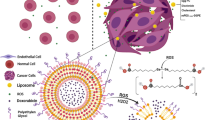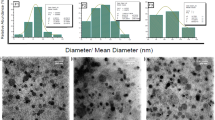Abstract
We describe here an improved method of encapsulating doxorubicin in liposomes using phosphatidylcholine, cholesterol and synthetic tetramyristoyl cardiolipin. With this new composition of lipids the entrapment of doxorubicin was found to be > 90%. Cytotoxicity studies using vincristine-resistant HL-60/VCR leukaemia cells showed that liposome-encapsulated doxorubicin reverses multidrug resistance 5-fold compared with conventional doxorubicin and at levels equivalent to that obtained using liposomes with natural cardiolipin. In normal mice, liposome-encapsulated doxorubicin was much less toxic than the conventional drug. A dose of 25 mg kg-1 i.v. of conventional doxorubicin produced 100% mortality in mice by day 14, whereas liposomal doxorubicin exhibited only 10% mortality by day 60. Liposomal doxorubicin demonstrated enhanced anti-tumour activity against murine ascitic L1210 leukaemia compared with conventional doxorubicin. At a dose of 15 mg kg-1, liposomal doxorubicin increased the median life span with 12 of 18 long-term (60 days) survivors compared with only 3 of 18 with conventional drug. Mice injected i.v. with liposomal doxorubicin had plasma levels 44-fold higher than conventional doxorubicin, producing significantly higher (P < 0.02) area under the plasma concentration curve. An altered tissue distribution was also observed with liposomal doxorubicin; cardiac tissue demonstrating at least 2-fold lower levels with liposomal doxorubicin probably accounting for its lower toxicity. This altered pharmacokinetics of liposome-encapsulated doxorubicin, providing enhanced therapeutic advantage and the ability to modulate multidrug resistance, could be useful in a clinical setting.
This is a preview of subscription content, access via your institution
Access options
Subscribe to this journal
Receive 24 print issues and online access
$259.00 per year
only $10.79 per issue
Buy this article
- Purchase on Springer Link
- Instant access to full article PDF
Prices may be subject to local taxes which are calculated during checkout
Similar content being viewed by others
Author information
Authors and Affiliations
Rights and permissions
About this article
Cite this article
Gokhale, P., Radhakrishnan, B., Husain, S. et al. An improved method of encapsulation of doxorubicin in liposomes: pharmacological, toxicological and therapeutic evaluation. Br J Cancer 74, 43–48 (1996). https://doi.org/10.1038/bjc.1996.313
Issue Date:
DOI: https://doi.org/10.1038/bjc.1996.313
This article is cited by
-
Hydroxycamptothecin liposomes inhibit collagen secretion and induce fibroblast apoptosis in a postlaminectomy rabbit model
European Journal of Orthopaedic Surgery & Traumatology (2013)
-
An efficient and novel method for the synthesis of cardiolipin and its analogs
Lipids (2004)



